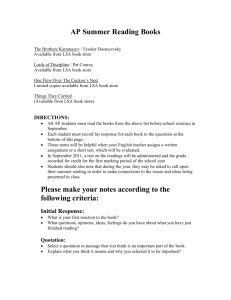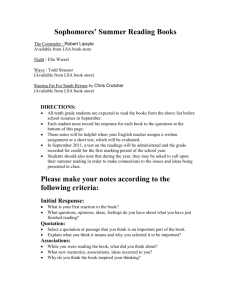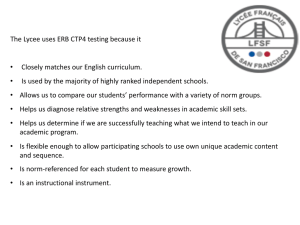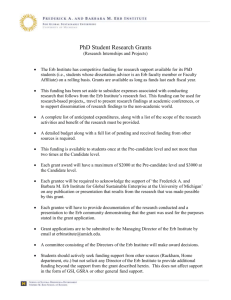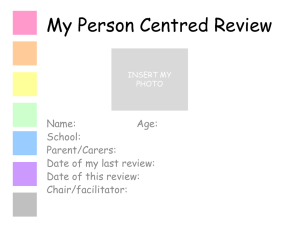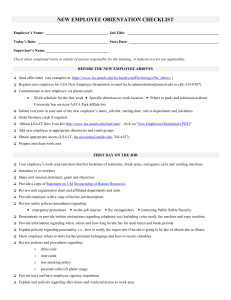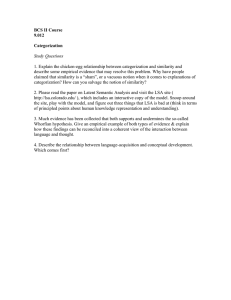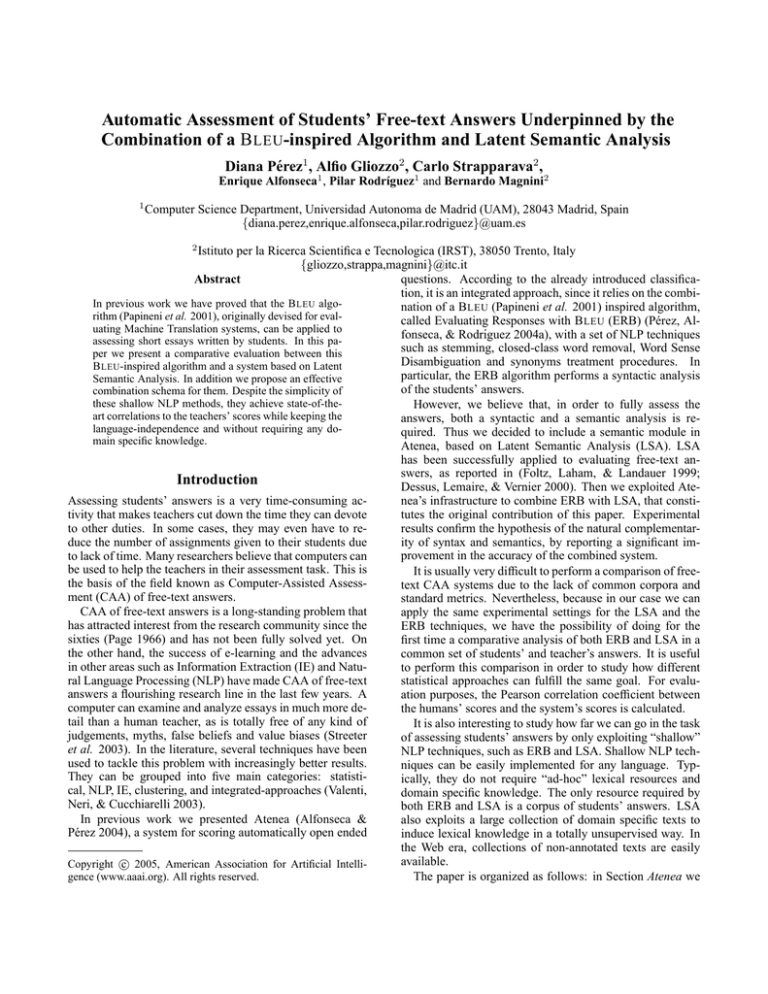
Automatic Assessment of Students’ Free-text Answers Underpinned by the
Combination of a B LEU-inspired Algorithm and Latent Semantic Analysis
Diana Pérez1 , Alfio Gliozzo2 , Carlo Strapparava2 ,
Enrique Alfonseca1 , Pilar Rodrı́guez1 and Bernardo Magnini2
1
Computer Science Department, Universidad Autonoma de Madrid (UAM), 28043 Madrid, Spain
{diana.perez,enrique.alfonseca,pilar.rodriguez}@uam.es
2
Istituto per la Ricerca Scientifica e Tecnologica (IRST), 38050 Trento, Italy
{gliozzo,strappa,magnini}@itc.it
questions. According to the already introduced classificaAbstract
tion, it is an integrated approach, since it relies on the combiIn previous work we have proved that the B LEU algonation of a B LEU (Papineni et al. 2001) inspired algorithm,
rithm (Papineni et al. 2001), originally devised for evalcalled Evaluating Responses with B LEU (ERB) (Pérez, Aluating Machine Translation systems, can be applied to
fonseca, & Rodrı́guez 2004a), with a set of NLP techniques
assessing short essays written by students. In this pasuch as stemming, closed-class word removal, Word Sense
per we present a comparative evaluation between this
Disambiguation and synonyms treatment procedures. In
B LEU-inspired algorithm and a system based on Latent
particular, the ERB algorithm performs a syntactic analysis
Semantic Analysis. In addition we propose an effective
of the students’ answers.
combination schema for them. Despite the simplicity of
these shallow NLP methods, they achieve state-of-theHowever, we believe that, in order to fully assess the
art correlations to the teachers’ scores while keeping the
answers, both a syntactic and a semantic analysis is relanguage-independence and without requiring any doquired. Thus we decided to include a semantic module in
main specific knowledge.
Atenea, based on Latent Semantic Analysis (LSA). LSA
has been successfully applied to evaluating free-text answers, as reported in (Foltz, Laham, & Landauer 1999;
Introduction
Dessus, Lemaire, & Vernier 2000). Then we exploited Atenea’s infrastructure to combine ERB with LSA, that constiAssessing students’ answers is a very time-consuming actutes the original contribution of this paper. Experimental
tivity that makes teachers cut down the time they can devote
results confirm the hypothesis of the natural complementarto other duties. In some cases, they may even have to reity of syntax and semantics, by reporting a significant imduce the number of assignments given to their students due
provement in the accuracy of the combined system.
to lack of time. Many researchers believe that computers can
be used to help the teachers in their assessment task. This is
It is usually very difficult to perform a comparison of freethe basis of the field known as Computer-Assisted Assesstext CAA systems due to the lack of common corpora and
ment (CAA) of free-text answers.
standard metrics. Nevertheless, because in our case we can
CAA of free-text answers is a long-standing problem that
apply the same experimental settings for the LSA and the
has attracted interest from the research community since the
ERB techniques, we have the possibility of doing for the
sixties (Page 1966) and has not been fully solved yet. On
first time a comparative analysis of both ERB and LSA in a
the other hand, the success of e-learning and the advances
common set of students’ and teacher’s answers. It is useful
in other areas such as Information Extraction (IE) and Natuto perform this comparison in order to study how different
ral Language Processing (NLP) have made CAA of free-text
statistical approaches can fulfill the same goal. For evaluanswers a flourishing research line in the last few years. A
ation purposes, the Pearson correlation coefficient between
computer can examine and analyze essays in much more dethe humans’ scores and the system’s scores is calculated.
tail than a human teacher, as is totally free of any kind of
It is also interesting to study how far we can go in the task
judgements, myths, false beliefs and value biases (Streeter
of assessing students’ answers by only exploiting “shallow”
et al. 2003). In the literature, several techniques have been
NLP techniques, such as ERB and LSA. Shallow NLP techused to tackle this problem with increasingly better results.
niques can be easily implemented for any language. TypThey can be grouped into five main categories: statistiically, they do not require “ad-hoc” lexical resources and
cal, NLP, IE, clustering, and integrated-approaches (Valenti,
domain specific knowledge. The only resource required by
Neri, & Cucchiarelli 2003).
both ERB and LSA is a corpus of students’ answers. LSA
In previous work we presented Atenea (Alfonseca &
also exploits a large collection of domain specific texts to
Pérez 2004), a system for scoring automatically open ended
induce lexical knowledge in a totally unsupervised way. In
the Web era, collections of non-annotated texts are easily
available.
c
Copyright 2005, American Association for Artificial Intelligence (www.aaai.org). All rights reserved.
The paper is organized as follows: in Section Atenea we
give a general overview of the internal architecture of Atenea to focus in the description of both the ERB and the LSA
modules. In the same section we describe the system combination strategy we adopted to combine ERB and LSA. In
Section Experimental settings we describe the corpora used
for training and evaluating our systems. In section Evaluation we compare the performances of all the “basic” modules
and their combination. Finally, in the last section, we draw
some conclusions and discuss some future developments.
We have modified the original algorithm so that it takes
into account not only the precision (the original B LEU score)
but also the recall that is calculated by studying the percentage of the references that is covered by the student’s answer
(Pérez, Alfonseca, & Rodrı́guez 2004b), using a Modified
Brevity Penalty (MBP) factor. We have called this B LEUinspired algorithm Evaluating Responses with B LEU (ERB).
Equation 1 shows the final formula for calculating the score
of an answer a. n represents the length of the n-grams, and,
N is the highest value than n can take.
Atenea
Atenea (Pérez, Alfonseca, & Rodrı́guez 2004a; Pérez, Alfonseca, & Rodrı́guez 2004b; Alfonseca & Pérez 2004) is
a CAA system for automatically scoring students’ short answers. It was developed as a web-based application so that it
can be accessed through any web browser connected or not
to the Internet.
In order to assign the scores, Atenea has access to a
database of questions associated to a set of references (i.e.
free-text answers written by teachers). As an option, the
best students’ answers can be included in the reference set
(Pérez, Alfonseca, & Rodrı́guez 2004b). Each time a student
logs into the system, Atenea asks him or her a question chosen from the database in a random way or depending on the
student’s profile (Alfonseca et al. 2004) and compares the
answer typed by the student with the associated references.
The internal architecture of Atenea is composed of the
ERB module and of several shallow NLP modules. First of
all, both the student’s answer and the reference answers are
tokenized. Secondly, the “basic” modules (i.e. Blue, ERB,
LSA) are invoked to independently assign a score to the answer. Finally, their outputs are combined to compose the
final score provided by the system to the student’s answer.
The framework provided by Atenea allows us to independently evaluate both the ERB and the LSA algorithms and
to combine them, just by setting up the Atenea’s configuration file. In the following subsections we will describe the
two basic algorithms (ERB and LSA) we used for our experiments, then we will introduce a framework for combining
them.
ERB
The ERB algorithm compares the student’s answer and
the references using a modified version of the n-gram cooccurrence scoring algorithm called B LEU (Papineni et al.
2001). The core idea of these algorithms is that the more
similar a student’s answer (the candidate text) is to the teachers’ answers (the references), the better it is, and, consequently, it will have a higher score.
B LEU uses a Modified Unified Precision (MUP) metric
that clips the frequency of the n-gram according to the number of times it appears in the candidate and in the references.
MUP must be calculated for each value of n, which usually
ranges from 1 to 4. For longer n-grams from the candidate
text, it will be unlikely to find them in the references. Next,
a weighted sum of the logarithms of MUPs is performed.
In the last step, a penalization is applied to very short answers, which might be incomplete, by multiplying the previous value by a Brevity Penalty (BP) factor.
PN
ERBscore (a) = M BP (a) × e
n=0
log(M U P (n))
N
(1)
LSA
LSA (Deerwester et al. 1990; Foltz, Kintsch, & Landauer 1998) is an unsupervised technique to estimate term
and document similarity in a “cognitive” Latent Semantic
Space. The LSA space is obtained by performing a singular
value decomposition of the terms-by-documents matrix D
extracted from a large scale corpus. In other words, term cooccurrences in the corpus are captured by means of a dimensionality reduction operated on the matrix D. The vectors
in the original space are mapped into a lower dimensional
space, in which the sparseness problem disappears, and similarity estimation is more accurate. The resulting LSA vectors can be exploited to estimate both term and document
similarity.
Regarding document similarity, we used a variation of the
pseudo-document methodology described in (Berry 1992),
in which each document is represented by the sum of the
normalized LSA vectors for all the terms contained in it,
according to the tf-idf weighting schema commonly used
in Information Retrieval and Text Categorization (Sebastiani
2002).
It has been claimed (Deerwester et al. 1990) that, in the
LSA space, both polysemy (i.e. the ambiguity of a term that
can refer to different concepts) and synonymy (i.e. the fact
that the same concept, in a context, can be referred to by
different terms) are implicitly represented. It is very important to consider those aspects when evaluating students’
answers. For example both pc and laptop can be used to denote a computer; architecture has a sense in the field C OM PUTER S CIENCE and a different one in the field B UILD ING I NDUSTRY .
Polysemy and synonymy are modeled by exploiting the
information from an external corpus, providing the system
of an “a-priori” semantic knowledge about the language,
represented by a structure of semantically related terms.
Such structure allows the system “to see” more than the content actually expressed by the words themselves, improving the superficial text comprehension obtained by a simpler
string matching.
The LSA algorithm we have used to evaluate the students’
answers is defined as follows: let ~a be the pseudo-document
vector obtained from the student’s answer a and let R =
{r~1 , r~2 , . . . , r~n } be the set of the pseudo-document vectors
corresponding to the references; the LSA score is defined by
the mean of the pseudo-document similarities between ~a and
SET
1
2
3
4
5
6
7
8
9
10
NC
38
79
96
11
143
295
117
117
14
14
MC
67
51
44
81
48
56
127
166
118
116
NR
4
3
4
4
7
8
5
3
3
3
MR
130
42
30
64
27
55
71
186
108
105
Type
Def.
Def.
Def.
Def.
A/D
A/D
Y/N
A/D
Y/N
Def.
Desc
OS
OS
OS
OOP
OS
OS
OS
OS
OS
OS
Table 1: Evaluation datasets. Columns indicate: set number; number of candidate texts (NC), their mean length
(MC), number of reference texts (NR), their mean length
(MR), question type (Def = definitions; A/D = advantages/disadvantages; Y/N = justified Yes/No), and a short
description (OS = Operating System exam question; OOP =
Object-Oriented Programming exam question).
each vector r~i ∈ R. This score is then normalized in order
to return a value in the range [0,1], as defined by equation 2.
P
cos(~a, r~i )
+ 0.5
(2)
LSAscore (a) = r~i ∈R
2|R|
The combination of ERB and LSA
The LSA and the ERB algorithms differ substantially with
respect to the type of linguistic analysis performed. In addition, LSA accesses an external knowledge source. Hence,
the assessments of ERB and LSA can be considered independent. The independence of the systems outputs is a fundamental prerequisite to combine them, so it will be checked
in the evaluation. If it is satisfied, it is expected that the
performances of independent classifiers will be increased by
adopting a system combination schema (Florian et al. 2002).
The combination schema we adopted for our experiments is
the simple weighted sum of their outputs, described by
COM Bscore (a) = αERBscore (a) + (1 − α)LSAscore (a)
(3)
where α is a parameter that allows us to assign in advance
a weight to ERB or to LSA. In spite of its simplicity, this
combination schema is effective and very general. When α
is set to 0.5, equal weights are assigned to both systems. In
our experiments we have also tried to optimize α on the test
set, so as to measure the upper bound of our combination
method.
Experimental settings
To evaluate our systems, we built nine different benchmark
data sets from real exams in Spanish, and an additional one
with definitions obtained from Google Glossary (Pérez, Alfonseca, & Rodrı́guez 2004a). The ten sets are described in
Table 1. For each question, we collected a set of students’
answers and we asked two different human judges to assign
SET
1
2
3
4
5
6
7
8
9
10
Mean
BLEU
0.59
0.29
0.22
0.73
0.35
0.04
0.23
0.27
0.09
0.26
0.31
ERB
0.61
0.54
0.20
0.29
0.61
0.19
0.33
0.39
0.75
0.78
0.47
SA-LSA
0.71
0.39
0.17
-0.22
0.69
0.27
0.07
0.34
0.66
0.91
0.40
CS-LSA
0.49
0.20
-0.01
0.52
0.50
0.24
0.29
0.39
0.78
0.87
0.43
Table 2: Evaluation of BLUE, ERB, SA-LSA and CS-LSA.
The first column indicates the question number, the following ones report the correlation to humans’ scores achieved
by B LEU, ERB, SA-LSA and CS-LSA. The last row reports
the mean correlations.
a score to each of them. They also wrote the reference answers for each question. The set of reference answers is the
only knowledge source required by ERB, while LSA needs
an additional domain specific corpus to be trained.
The common test set of students’ answers allows us to
perform a comparative analysis of ERB, LSA and their combination. For evaluation purposes, the Pearson’s correlation coefficient between the humans’ scores and the system’s
scores is calculated.
To train the LSA system we used the two following corpora:
SA: It is a small corpus composed by 1.929 Student Answers collected in an Operating Systems course. They
have been automatically translated from Spanish to English by using Altavista Babelfish1 . To preserve a correct evaluation methodology, none of the students’ answers contained in this corpus is included in the evaluation datasets.
CS: It is a large collection of 142.580 texts from the ZiffDavis part of the North America Collection corpus. It
consists of English extracts and full articles from Computer Science magazines such as PC Week, PC User or
PC Magazine, and articles related to Computer Science
in more generic journals, such as The New York Times or
Business Week.
Evaluation
In this section we evaluate independently both the ERB and
the LSA systems in a common test set, described in the pre1
In a previous work (Alfonseca & Pérez 2004), we have observed that results obtained with ERB do not decrease when using
an automatic translation system to port the students’ answer to another language. Because the corpus used for training LSA is in
English, Altavista Babelfish (http://world.altavista.com/ ) has been
used to translate the Spanish training and evaluation set to English
in order to make a comparison with the English Ziff-Davis Corpus
that is used in the other experiments.
SET
1
2
3
4
5
6
7
8
9
10
Mean
BLEU
SA-LSA CS-LSA
0.69
0.60
0.40
0.32
0.25
0.21
0.77
0.79
0.50
0.40
0.08
0.05
0.24
0.25
0.36
0.30
0.30
0.20
0.55
0.45
0.41
0.36
ERB
SA-LSA CS-LSA
0.73
0.62
0.54
0.50
0.22
0.17
0.12
0.37
0.68
0.63
0.23
0.20
0.31
0.35
0.42
0.42
0.77
0.79
0.87
0.85
0.49
0.49
Table 3: Evaluation of the combined systems fixing α = 0.5.
Cells reports the correlations.
vious section, then we show the benefits of their combination.
The results of this first evaluation is shown in Table 2.
LSA has been trained on both the SMALL and the LARGE
corpora described in the previous section. With the terms
SA-LSA and CS-LSA we will refer respectively to the former and to the latter settings.
ERB is clearly the best “basic” system: it outperforms the
original Blue algorithm and it is more accurate than LSA
as well. Results also show that the accuracy of LSA improves when the CS corpus is used for unsupervised learning, even though the SA corpus describes the questions domain in much more detail. ERB is also complementary to
LSA for most of the questions: ERB achieved the best results just for three questions of ten; and all the systems we
compared are highly uncorrelated.
The complementarity of ERB and LSA allows us to combine them, adopting the system combination schema described previously. We have tried only the possibilities in
which we combined one syntactic approach (Blue or ERB)
with one semantic approach (SA-LSA and CS-LSA), discarding the other possibilities. Results are reported in Tables 3 and 4.
Table 3 shows the performances of the systems obtained
by combining SA-LSA, CS-LSA, BLEU and ERB. For all
the combined systems we fixed α to 0.5, so to assign the average score of the basic modules as a final output. The correlations achieved clearly show that the combination schema is
effective: except for the combination of BLEU and CS-LSA,
in all cases the result of the combined system is better than
the results as stand-alone applications. Interestingly, when
combined to ERB, both SA-LSA and CS-LSA provide the
same benefits, even if CS-LSA alone is more accurate than
SA-LSA.
To test how far we can go with our combination method,
we also estimated the best parameter settings, by simply optimizing the parameter α on the test set. The mean correlations of the combined systems are reported in Table 4. In
the same table we also report the value of the parameter α
exploited to achieve the best results. With this optimization technique, the best combination (ERB and CS-LSA)
SET
1
2
3
4
5
6
7
8
9
10
Mean
Alpha
BLEU
SA-LSA CS-LSA
0.73
0.61
0.44
0.28
0.25
0.09
0.60
0.81
0.59
0.55
0.13
0.14
0.23
0.33
0.43
0.45
0.45
0.62
0.74
0.84
0.46
0.47
0.3
0.1
ERB
SA-LSA CS-LSA
0.73
0.61
0.54
0.38
0.22
0.10
0.12
0.48
0.68
0.64
0.23
0.23
0.31
0.38
0.42
0.46
0.77
0.81
0.87
0.90
0.49
0.50
0.5
0.2
Table 4: Evaluation of the combined systems by optimizing
the parameter α. Cells reports the mean correlations and the
values of α at the bottom.
achieves a correlation of 50% that constitutes the best result
measured in our experiments.
Even if the difference is not very significant, the external large corpus used to train the CS-LSA has been proved
helpful also in combination with ERB. The best accuracy
has been obtained by combining ERB and CS-LSA and setting α to 0.2. It means that a lower weight has been assigned
to ERB.
In general, it is interesting to highlight that when combining ERB’s scores and LSA’s scores using the different
methods explained before, there is most of the times some
slight improvement in the correlation to the humans’ scores.
As expected, LSA’s accuracy improves when a big corpus
is provided for training, even if the SA corpus describes the
questions domain in much more detail. On the other hand,
the benefits of the bigger corpus are sensibly reduced when
LSA is combined with ERB. This is quite a relevant point,
since it means that, in our case, even using a generic corpus
(i.e. a corpus that does not include particular references to
the questions that we have evaluated) to train the LSA module, the accuracy in the automatic scoring process can be
improved.
Conclusions and future work
In this paper we have tested the hypothesis that combining different knowledge sources and algorithms is a viable
strategy for an automatic assessment of students’ free-text
answers. In particular we have presented a combination
schema for two different techniques: ERB and LSA. To
demonstrate our claim we have compared the performances
of each technique in the common experimental framework
provided by Atenea. Then we have evaluated their combination.
The results show that, tested as stand-alone modules, ERB
outperforms the others. Concerning LSA, using a big corpus
slightly improves its accuracy. This allows us to adapt the
system to different domains, by simply collecting domain
specific documents to train the LSA module.
The combination schema for ERB and LSA has also been
found effective: the combinations always perform better
than their constituent modules. Although we can obtain
slightly better results by optimizing the weights, simply using an equal weight for both systems is also an effective
strategy for combination. The mean correlation to the human’s scores has reached 50%.
It is important to highlight that none of the modules used
requires a deeper linguistic processing than just tokenization
and part-of-speech tagging; and the only lexical resources
used are the two corpora and the evaluation datasets. This
helps in keeping the portability across languages that shallow NLP techniques allow.
This paper opens the following prospective lines:
1. The proposed combinational schema allows us to easily
integrate LSA (and possibly many other NLP tools such
as anaphora resolution and parsing) inside the general architecture of Atenea. For the future we plan to integrate
some of these tools inside Atenea.
2. Furthermore, we believe that the idea of combining syntax and semantics can be further explored, by designing
more sophisticated system combination techniques and
more complex basic modules for text analysis.
3. We are also interested in following in much more detail
the new research direction opened by the use of automatic
Machine Translation in the field of CAA. Concretely, we
plan to compare the performances of our LSA system
when trained on fully monolingual settings with the results reported in this paper, for which the both the students’ and the references have been automatically translated, to prove the complete language-independence of
the whole procedure. This perspective is very attractive
especially to make Atenea helpful for foreign students,
that could be allowed to answer the question in their own
language.
4. Finally, we plan to go deeper in the direction of applying supervised and unsupervised Machine Learning techniques to the field of CAA, by approaching the task of
CAA of free-text answers inside the framework of kernel
methods.
Acknowledgments
This work has been sponsored by the Spanish Ministry of
Science and Technology, project number TIN2004-03140.
We also want to thank to Manuel Alfonseca, Rosa M. Carro
and Alvaro Ortigosa for their help in building the students’
answer corpus and to Milen Kouylekov for the generic Computer Science corpus.
References
Alfonseca, E., and Pérez, D. 2004. Automatic assessment
of short questions with a BLEU-inspired algorithm and a
shallow semantic representation. In Advances in Natural
Language Processing, volume 3230 of Lecture Notes in
Computer Science. Springer Verlag. 25–35.
Alfonseca, E.; Carro, R.; Freire, M.; Ortigosa, A.; Pérez,
D.; and Rodrı́guez, P. 2004. Educational adaptive hypermedia meets computer assisted assessment. In Proceedings
of the International Workshop of Educational Adaptive Hypermedia, collocated with the Adaptive Hypermedia (AH)
Conference.
Berry, M. 1992. Large-scale sparse singular value computations. International Journal of Supercomputer Applications 6(1):13–49.
Deerwester, S.; Dumais, S. T.; Furnas, G. W.; Landauer,
T.; and Harshman, R. 1990. Indexing by latent semantic
analysis. Journal of the American Society for Information
Science 41(6):391–407.
Dessus, P.; Lemaire, B.; and Vernier, A. 2000. Free text
assessment in a virtual campus. In Proceedings of the 3rd
International Conference on Human System Learning, 61–
75.
Florian, R.; Cucerzan, S.; Schafer, C.; and Yarowsky, D.
2002. Combining classifiers for word sense disambiguation. Natural Language Engineering 8(4):327–341.
Foltz, T.; Kintsch, W.; and Landauer, T. 1998. The measurement of textual coherence with latent semantic analysis. Discourse Processes 25(2-3). Special Issue: Quantitative Approaches to Semantic Knowledge Representations.
Foltz, P.; Laham, D.; and Landauer, T. 1999. The intelligent essay assessor: Applications to educational technology. Interactive Multimedia Electronic Journal of
Computer-Enhanced Learning 1(2).
Page, E. 1966. The imminence of grading essays by computer. Phi Delta Kappan.
Papineni, K.; Roukos, S.; Ward, T.; and Zhu, W. 2001.
B LEU: a method for automatic evaluation of machine
translation. Research report, IBM.
Pérez, D.; Alfonseca, E.; and Rodrı́guez, P. 2004a. Application of the B LEU method for evaluating free-text answers in an e-learning environment. In Proceedings of the
Language Resources and Evaluation Conference (LREC2004).
Pérez, D.; Alfonseca, E.; and Rodrı́guez, P. 2004b. Upper
bounds of the BLEU algorithm applied to assessing student
essays. In Proceedings of the 30th International Association for Educational Assessment (IAEA) Conference.
Sebastiani, F. 2002. Machine learning in automated text
categorization. ACM Computing Surveys 34(1):1–47.
Streeter, L.; Pstoka, J.; Laham, D.; and d. MacCuish. 2003.
The credible grading machine: Automated essay scoring in
the dod. In Proceedings of Interservice/Industry, Simulation and Education Conference (I/ITSEC).
Valenti, S.; Neri, F.; and Cucchiarelli, A. 2003. An
overview of current research on automated essay grading.
Journal of Information Technology Education 2:319–330.

